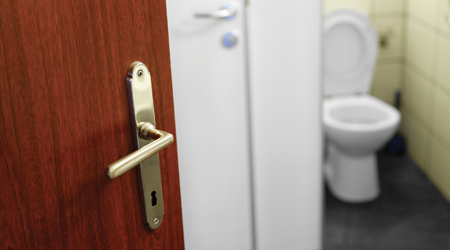
Maintaining a restroom is time consuming. Although small, they’re loaded with surfaces to clean and disinfect (toilets, sinks, urinals, stalls, partitions, fixtures, mirrors and countertops) and items to restock. All of that can add up to at least 10 minutes of work in a single-stall restroom, and that’s without floor care.
What’s more, facilities executives often expect restrooms to be cleaned multiple times throughout the day.
Clearly, restroom maintenance can cost cleaning departments a pretty penny in labor. Unsurprising, managers are always looking to create efficiencies that will cut labor costs or free up staff to focus on other responsibilities — without sacrificing the quality of care given to the all-important bathroom.
“Yes, the entrance is the first impression of a building, but the bathrooms are how you’re really judged,” says David Keller, First Quality Supply, Minneapolis. “Too often, you’re so busy taking care of the common areas that you’re not able to find enough time to clean the bathrooms. But departments have to find ways to be more efficient in that space.”
Often, mechanizing a task will make for quicker cleaning. That’s why many cleaning executives focus on equipment when they are looking for productivity gains.
“If there’s a way you can clean the restrooms in a fashion that you touch things less, get a better result and do it faster, it seems like a good idea to consider,” says Keith Schneringer, director of channel marketing and sustainability for WAXIE Sanitary Supply, San Diego.
Multitasking Machines
Touchless-cleaning devices, also referred to as combination machines, are still a small seller compared to traditional cleaning tools such as mops and rags, but they’ve been growing in popularity over the last decade.
This automated machinery allows custodians to spray cleaning solution (pre-diluted via an on-board metering system) on fixtures, floors and other surfaces, then loosen soil using the sprayer or other on-board tools like a scrubber or bowl brush, and finally remove the contaminants by either vacuuming the floor dry or squeegeeing it down the floor drain.
Done correctly, the process cleans nearly everything in the restroom — all with one machine and all without touching contaminated surfaces — leaving only restocking chores.
“You’re basically rolling in there and you’re like Batman with his utility belt,” Schneringer says.
These units roll on casters, so workers no longer need to lift and move a heavy bucket of water. They can also easily get into areas that would normally require bending or other awkward movements to reach.
“You’re getting janitors off their hands and knees,” Schneringer says.
Combo machines can cost upwards of $6,000, but manufacturers say the sizable initial investment can be recouped fairly quickly in labor savings. When used correctly, the equipment can dramatically reduce restroom cleaning times.
“If it takes you 30 minutes to clean a restroom with a conventional method, you may be able to cut that to 10 minutes with this approach,” Schneringer says. “That can add up to a lot of time and labor savings if you have 20 restrooms.”
Finally, combo machines are often more effective than manual cleaning methods.
“You get a better result and faster, so it’s a win-win situation,” Schneringer says.
What are the downsides? While the machines have gotten smaller over the years, they might still be too large to use in very small restrooms. They can also only be used in spaces with tiled floors. And unless using a vacuum to remove water, the restrooms must have floor drains. Finally, of course, the price tag may be beyond the reach of many smaller facilities.
Streamlining Restroom Cleaning Processes

 The Down and Dirty on Cleaning in Virus Season
The Down and Dirty on Cleaning in Virus Season How Surfactant Use is Expanding in Commercial Cleaning
How Surfactant Use is Expanding in Commercial Cleaning Operational Excellence Series 2025: Better Budgeting
Operational Excellence Series 2025: Better Budgeting